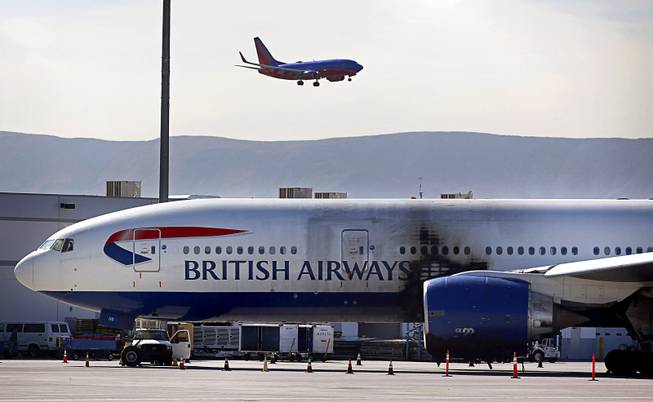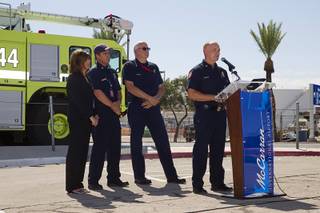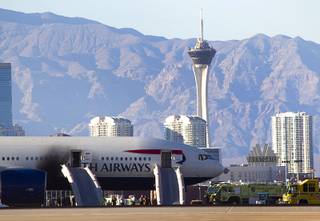
John Locher / AP
A damaged British Airways Boeing 777-200 sits at McCarran International Airport on Wednesday, Sept. 9, 2015, in Las Vegas. An engine caught fire before takeoff Tuesday, forcing the evacuation of the crew and passengers.
Published Wednesday, Sept. 9, 2015 | 12:59 p.m.
Updated Wednesday, Sept. 9, 2015 | 4:55 p.m.
As an airline pilot for 42 years, including 14 months in the cockpits of Boeing 777 jets, Steve Abdu knows a good job by an air crew when he sees it.
And it doesn't get better than the performance by the crew of a British Airways 777 that was evacuated Tuesday after its left engine caught fire at McCarran International Airport, he said.
"They have to evaluate which exits are available and safe to use," said Abdu, now an executive with Indiana-based Expert Aviation Consulting. "You don't want people evacuating from the left side of the plane. They probably cut the number of exits in half to evacuate 157 people. It was an excellent job on the part of the crew."
Abdu was among a chorus of people praising the crew of Flight 2276 and McCarran firefighters today for heading off what could have been a much more disastrous situation. Although the outbound plane was speeding down the runway at about 100 mph when the fire was detected, officials said, the pilots were able to stop the aircraft before it took off, allowing the crew to quickly get passengers out. From there, firefighters responded within a minute of being called, and quickly extinguished the blaze.
Twenty-seven passengers were treated for injuries — most related to sliding down the inflatable emergency slides deployed after the plane came to a halt.
"They were lucky it happened when they were on the ground," Abdu said. "They didn't have to deal with it airborne."
Eric Schoneberger, a former Navy aviator and Delta Airlines pilot, said the response by McCarran firefighters was "what you always hope for" as a pilot.
"They could be on a shift change, could be out to lunch," he said. "But the situation you had there was exactly what those guys are there for. They train meticulously for things like this."
Abdu and Schoneberger, an instructor at Nashua Flight Simulator in Manchester, N.H., said the 777's design and engineering also played a role in helping avoid a tragedy.
Schoneberger said the aircraft features an automatic braking system and aerodynamic spoilers on the top of the wings that help bring it to a quick stop in an emergency. There also are redundant warning devices and other systems that would help pilots contend with a fire, including a design that allows the aircraft to fly on one engine and have the other drop off short of damaging the wing if it were on fire.
"That airplane has a tremendous safety record," Abdu said. "It's one of the most popular airliners in the world."
So what happened to Flight 2276?
The cause of the fire is under investigation, but Abdu said he was interested to learn that the flames weren't doused by an on-board fire extinguishing system.
"One of the reasons that could happen was maybe it was a fuel line that broke," he said. "And once the fire starts, if the fuel pumps are still pumping fuel into it, (the extinguishing system) isn't going to put it out."
The pilots and landing crews would have received extensive training to handle an aborted take-off, an engine fire on the tarmac and a quick evacuation, Schoneberger and Abdu said.
Though many experts and passengers have praised the pilot and crew for their quick response in an emergency situation, one passenger, Summerlin resident Stuart Scheinman, said those stories don’t paint the full picture.
Though the captain did a “marvelous job hitting the brakes,” Scheinman said it seemed like the crew panicked. Passengers were initially told to stay in their seats as they were “watching the windows melt,” said Scheinman, the owner of a collectible business who was taking the flight for a business trip. It wasn’t until the assistant pilot came out to investigate the situation that the passengers were told to open the doors and evacuate immediately, he said.
And after they evacuated the plane, Sheinman said no police were present. The passengers wandered around the tarmac “like an episode of the Walking Dead” for 45 minutes until someone rounded them up and took them back to the terminal. The airport provided no additional support or guidance to passengers, he said.
“I understand this has never happened, 99.9 percent of all pilots and flight attendants have never experienced anything like this,” Scheinman said. “But you need to be prepared for it.”
Even today, Scheinman said British Airways never reached out to him to let him know when he and his significant other could expect to leave on another flight nor had they apologized for the incident. He's scheduled to be on a rescheduled flight at 6:30 this evening.
Clark County Fire Chief Greg Cassell said the crew's response was textbook.
"They were very calm," he said. "They did a great job deploying those chutes, making sure the passengers exited the correct side of the aircraft, got them out and away from the aircraft so that we could then corral them into a group and get them to an area where we could check on their injuries and make sure they were OK."
Bill Hutfilz, Clark County Fire Department aircraft rescue and firefighting training officer, said firefighters' worked "flawlessly" in getting to the aircraft and putting out the blaze quickly.
"What they did yesterday is just a testament to the training that they do," he said.
Abdu said the type of injuries suffered by passengers were typical in evacuations.
"It's probably 30 feet from the airplane exit to the ground," he said. "And people are pushing and jumping, so it's not uncommon" for some to be injured on their way down the slides.
There were reports that some passengers stopped to pull their luggage out of overhead bins, which could have created greater problems in the evacuation.
"It can greatly hinder it, because some of the exits are small," Abdu said. "When people were trying to get bags down, obviously it can slow the operation down."



Join the Discussion:
Check this out for a full explanation of our conversion to the LiveFyre commenting system and instructions on how to sign up for an account.
Full comments policy